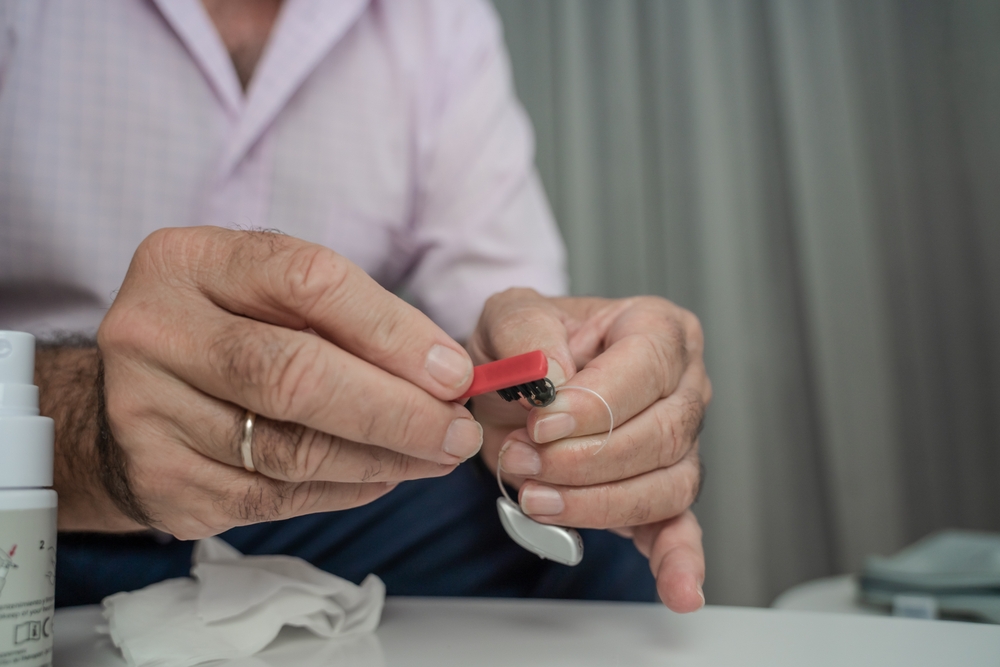After you have become accustomed to wearing your hearing aid, it becomes a vital element of your daily routine. The thought of it breaking down can be daunting, not simply because of the inconvenience but also due to the potential cost of repairs or replacements.
Tips for maintaining and maximizing your hearing aid functionality
Understanding what can damage your hearing aid and learning how to maintain it effectively will help you maintain its functionality and ensure it continues to enhance your quality of life.
Effective care of batteries
Your hearing aid’s functionality is highly dependent on its battery. Hence, it is important to choose the appropriate batteries for your device. Talk to your hearing specialist to determine the best battery variety for your model.
It is equally significant to handle the batteries carefully. Oils, dirt, and moisture from your hands can contaminate the batteries, leading to potential damage.
Before switching out the battery, ensure your hands are clean and thoroughly dry to prevent any moisture from entering the device.
Follow the manufacturer’s guidelines meticulously, especially concerning battery care. Turn off your hearing aid when it’s not being used to protect battery life and store it in a safe, dry place. Familiarizing yourself with the battery’s normal lifespan is also worthwhile.
Make a note on your calendar each time you change the battery, so you can estimate when it will need changing again. It’s important to have a spare battery with you at all times, particularly when you are not at home, in order to avoid being stuck without power unexpectedly.
Minimize the risk of moisture damage
As electronic devices, hearing aids are vulnerable to moisture. Even brief contact can cause harm or complete failure of the device. Safeguard your hearing aid’s performance by acquiring a specialized drying device to maintain its functionality by removing moisture. This device provides a safe and dry atmosphere for your hearing aid when not in use, protecting it from damage caused by excessive moisture.
When engaging in physical activities that trigger sweating, you may consider taking out your hearing aid to prevent moisture damage. Having said that, speak with your hearing specialist first, as removing your hearing aid during exercise, particularly outdoors, might pose safety risks by limiting your ability to hear environmental sounds like traffic or alarms. If necessary, opt for indoor exercise where it’s safer to be without your hearing aid, and always remember to remove your device before showering or going for a swim.
Furthermore, it is recommended to avoid using spray deodorants, hairspray, and any other aerosol products when your hearing aid is in use. Extended exposure to these products can lead to harm to the device, as the moisture and chemicals they consist of can accumulate and result in long-term deterioration over time. Use these products before putting on your hearing aid to decrease exposure.
Control earwax buildup
Although earwax serves as a natural barrier, shielding your ears from debris, dirt, and tiny insects, it can also hamper the proper functioning of your hearing aid. The accumulation of earwax in the device can result in it not functioning correctly. To control this, have your ears checked out by your hearing specialist or physician to evaluate the level of earwax buildup and create an appropriate cleaning routine for both your ears and your hearing aid.
Cleaning your ears safely is crucial– never insert foreign objects into your ear canal. Instead, allow warm water to flow into your ears in the course of showers, which can help break up and flush away some of the wax. It is also suggested to have your ears cleaned routinely by a professional. While this may seem inconvenient, it’s far less problematic than dealing with a malfunctioning hearing aid dued to excessive earwax.
When it comes to cleaning your hearing aid, follow the manufacturer’s instructions carefully.
Various kinds of hearing aids may need specific cleaning methods, and using an incorrect technique might damage your device. If you’re unsure about the proper cleaning method, consult your hearing specialist or hearing aid provider to ensure you’re taking the correct steps to protect your device from earwax damage.
Simple methods to ensure lasting reliability
Once you get used to using your hearing aids, they become a crucial facet of your day-to-day routine, making it difficult to picture life without them. By taking a few simple precautions, you can avoid damage and ensure your hearing aids continue to be reliable for years to come. Routine maintenance, appropriate storage, and cautious handling are essential to keeping your hearing aids in optimum condition, allowing you to continue enjoying the enhanced quality of life they supply.
If you are having difficulties with your hearing aid or need to schedule a routine maintenance appointment, please arrange for a visit.
